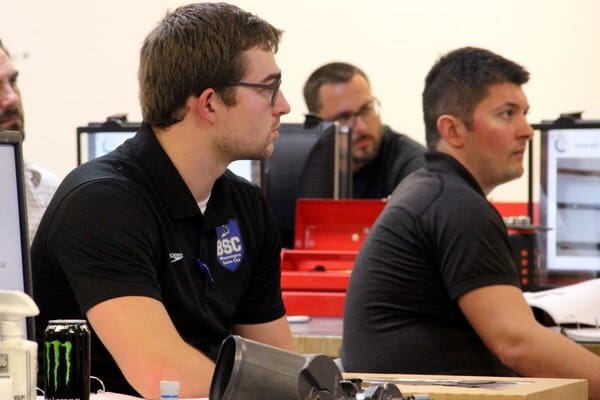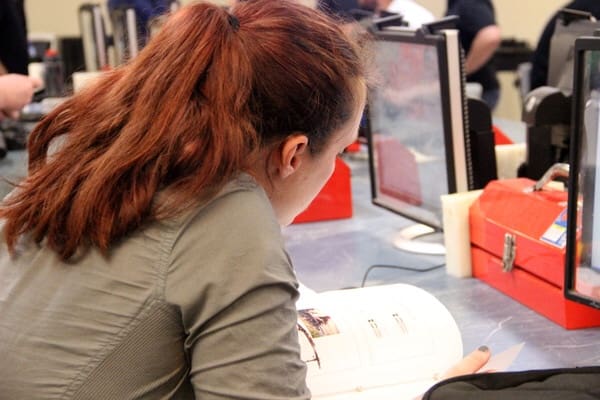CRANE, Ind. – Naval Surface Warfare Center, Crane Division (NSWC Crane) hosted Expeditionary professionals for its first Light Weapon Design Course led by Cranfield University, a postgraduate university based in the United Kingdom that specializes in defense technology.

“This is the first time the Light Weapon Design has been brought to Crane,” says Adam Parsley, a Division Manager at NSWC Crane. “The Small Arms Weapon Systems Division was able to really enhance the learning experience for all the students with the access we have to weapons, ammunition, and the firing range.”
Parsley says the Light Weapon Design Course teaches the fundamentals of weapon operation and design.
“It focuses on the development of light weapons, or small arms, and their design and operation today,” says Parsley. “Through this course, our Expeditionary employees will better understand the reasoning behind design parameters – heat dissipation, durability, signature, recoil – and will have better concepts of how to design and test weapons.”

Chris Shaffer, an engineer at NSWC Crane, took part in Cranfield’s Light Weapon Design Course. Shaffer says these highly specialized courses from Cranfield help with workforce development.
“These courses offer Expeditionary professionals the opportunity to gain unique, hands-on experience,” says Shaffer. “They can take the engineering concepts, ideas, and skills they learned in undergrad and apply them to military devices. For these jobs in Expeditionary Warfare, the workforce needs specialized knowledge.”
Students from other commands traveled to NSWC Crane to participate in the course.
“The Light Weapon Design Course was fantastic,” says Erin Thompson, a Weapons Team Engineer at Marine Corps Systems Command. “I learned so much that will be directly applicable to my job and make me more effective for the Marine Corps. Chris Shaffer and the Crane team were great and the access we were afforded to the weapons was incredibly beneficial.”

“I thought the class was really well done,” says Elizabeth Palm, a Test Officer at US Army Cold Regions Test Center. “Adam and Chris did a great job coordinating with Cranfield to be able to offer so much hands-on time with a variety of weapons, especially the foreign ones. And of course any chance to get out on the range is always a good day!”
Cranfield University is in its second year of offering Masters of Science courses at Crane. The Light Weapon Design Course is the seventh Cranfield course since its inception.
“Cranfield offers courses in weaponry, munitions, sensors, and communications that most colleges and universities just don’t have,” says Parsley. “They also have packaged these courses in this condensed, one-week format that is optimal for the working professional who wants to pursue an advanced degree.”
NSWC Crane is a naval laboratory and a field activity of Naval Sea Systems Command (NAVSEA) with mission areas in Expeditionary Warfare, Strategic Missions and Electronic Warfare. The warfare center is responsible for multi-domain, multi- spectral, full life cycle support of technologies and systems enhancing capability to today’s Warfighter.
By NSWC Crane Corporate Communications


PKM – 16.5 lbs, 7.62x54mm, FITFO!!!!
240B – 27.6 lbs, 7.62 NATO
240L – 22 lbs, ”
MK48 – 18.75 – 22 lbs, ”
BLUF: 240 was meant to be a mounted a MG, Rooski’s had a true light-weight MG for nearly 60 years, WTF???!
Not quite
M240 originally was a co-ax/flex MG…in US service.
PK series in service about 1961
MAG series in service about 1957
You could argue (whatever the other relative merits) that the PK series save mass when measured against the M60 primarily via lighter barrel & bipod.
Dude, Linz, I have no idea what “flex” is supposed to mean, but co-ax is a mounted machine gun. Read any post from an Army or USMC machine-gunner in last 15+ years and you would understand what I’m referring to. I carried a MK48, so I guess I’m one of the “luckier” ones! Still way over weight and under-distance to what our goat-f@$&*ing adversaries carry and effectively engage, while staying out of range.
Read up!
Ed,
The US military adopted variants of the FN MAG for use on AFV (after trials against M60 variants) as M240 in both co-axial & flexible (‘flex’) mount roles.
Use of M240 in the ground role came somewhat later & initially used converted vehicle guns.
WTF do you not understand about the 240 NOT being designed for ground-Infantry combat??! It is TOO heavy and makes maneuver warfare cumbersome!…..as compared to German WWII designs and the PKM of Rooski/ Goat F@##$er current use.
OUT.
Incorrect.
M240 are MAG.
So what do you think MAG were designed for? The bipod, butstock, pistol grip might be a clue.
MAG were indeed designed for ground combat….starting with their adoption by Sweden in that role (6.5x55mm initially) and by the UK as L7A2 (7.62x51mm).
Could the MAG be lighter? Yes.
Could MAG be simpler? Yes.
Are there equivalent or better designs out there? Yes.
Were MAG designed for ground combat? Yes
Agreed
Hahaha. “OUT” when ending an incorrect argument. Just as cringey as “Full Stop”.
Fun fact – the SA80 series was originally designed by a team with zero experience in designing small arms. Allegedly, no one on the team had ever even used a firearm before.
Guess that explains a few things….
That is utterly ridiculous! In a logic/common sense world, end users and SME’s should always be part of the process. So sad!
Your comments must be based on urban legend. They are 100% false. The SA80 was based on the AR-18 and the EM-2. The EM-2 was a competitor to the FN FAL and shot an intermediate round. How the final SA-80 came out is more a example of bureaucracy and politics. Interestingly the 270/280 British round performance is close to what the Army is looking for in NGSAW program.
Getting back to the program. At Pax River US Navy Test Pilot School (when I was there 98-02) ran Short Courses to teach engineers, especially those right out of school and new hires, a wide range of subjects. The short courses were a huge success.
While the SA80 was based on the AR-18, the prototypes were total bodge jobs and the the *production team* that took over once Enfield shut down had little to no firearms manufacturing experience. This lead to numerous “we’ll just make this part cheaper I can’t see what will go wrong” mistakes.
I’ve held initial prototypes in the Pattern Room. They are reweld AR-18s with straightened coat hangers to attach the charging handle to the action.
EM-2 or XL64?
I don’t believe that is strictly true.
For a quick education, read ‘The Last Enfield’ by Raw.
My understanding is that Ganton Glock too had never designed a firearm, and wasn’t even a “gun guy”, before he saw the equivalent of a bid solicitation for a new sidearm for the Austrian army. He had designed and sold a lot of bayonets and entrenching tools and thought “Why not design a pistol from a clean sheet? It’s just another engineering project”. So, he approached the problem as a complete industry outsider, and the rest is now history!
I work within the Lethality Section at the Infantry Trials and Development Unit. The Light Weight Weapon Design Course is exemplary and the instruction is first class. I highly recommend this course to anyone that deals with small arms weapons and trials.
Thanks again to Cranfield University and their team.
Kind Regards
Brian
Strike-Hold.
Please show me where you recieved those facts?